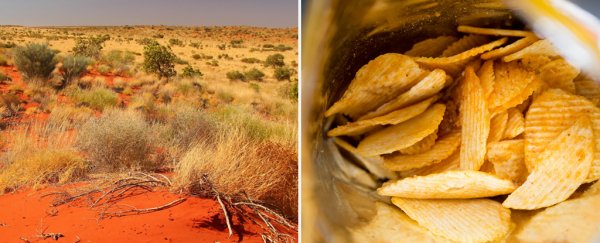One of the first things we're told not to do in chemistry class is eat or lick the samples. But once you're a grown up scientist, it looks like those classroom rules no longer apply.
While cataloguing a bunch of native grass species, researchers in Australia discovered that one of them tastes exactly like the flavouring found on salt and vinegar chips. And yes, they did that by literally licking their fingers.
As many surprise findings, the discovery happened by accident while scientists were working overtime late at night. In this case, biologists from the University of Western Australia (UWA) were handling specimens of the grass species in the lab.
"Someone licked their hand at some point and tasted that flavour," biologist Matthew Barrett told Lisa Morrison at ABC North West.
The grasses handled by the researchers were all types of spinifex (of the Triodia genus) - an iconic native Australian plant known for its hardiness and ability to resist even the worst droughts in the arid inland of the red continent.
At least 64 different Triodia species are found across Australia, although researchers think the number might be even larger, as some species have only a small range and are tucked away in difficult to access locations.
New discoveries and genetic revisions are changing the taxonomy of these spiky grasses, and it was during one such taxonomic revision that the team stumbled upon the striking flavour of one of the new species they were describing.
The strange flavouring appears to be coming from tiny droplets of liquid found on younger grass stems.
"It looks pretty inconspicuous when you first get to it, but if you look at it very closely it has very, very minute sparkling droplets on the stems," said Barrett.
"When you lick them, they taste like salt and vinegar chips."
The tangy, sparkly grass - Triodia scintillans - is now one of a group of eight new species described by Barrett and UWA PhD student Ben Anderson.
In their study, the researchers note that the flavour droplets found on the grass "can remain a viscous liquid or become crystalline following specimen drying." However, the stuff is water-soluble and can be washed off the leaves.
Many grasses secrete sticky sugars, proteins, and even salt from teeny tiny microhairs on the surface of their leaves, and the researchers hypothesise that the sparkly droplets they've found on T. scintillans are homologous to this behaviour.
While they mention the sparkly droplets as part of the new species description, the flavour of the grass didn't make it into the study.
But this finding is just one more thing to add to the coolness factor of this iconic Australian plant. Indigenous Australians have known about some of its clever properties all along, as they've been using spinifex resins as adhesive for thousands of years.
And science is catching up as well - last year, another team of Australian researchers discovered a way to extract nanocellulose out of spinifex and used it to create incredibly sturdy natural latex.
The study was published in Australian Systematic Botany.
